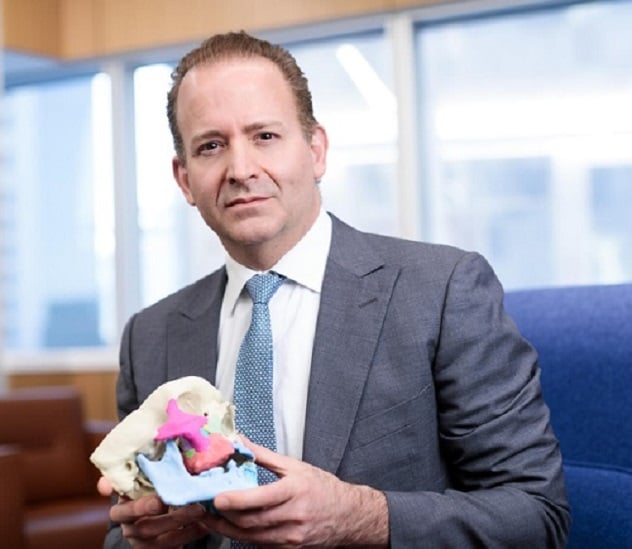Sept. 24, 2024
 3D printed model
3D printed model
Dr. Mardini uses a 3D printed model of cleft lip and palate in surgical planning.
At Mayo Clinic Children's Center, care for children with cleft lip and cleft palate includes specialists from plastic surgery, otolaryngology, orthodontics, clinical genomics, neurosurgery, oral and maxillofacial surgery, orthodontics, speech pathology, medical social services, and more. Test results are typically available within a day or two, and the patient's care is comprehensively coordinated by an extended team.
Over a two-day period, the Cleft and Craniofacial Clinic team at Mayo Clinic's campus in Rochester, Minnesota, conducts a complete evaluation using advanced imaging and 3D surgical planning when appropriate.
"The team members meet to discuss their findings and develop a treatment plan, tailored to each patient's needs," says Samir Mardini, M.D., chair of Plastic Surgery at Mayo Clinic in Rochester, Minnesota. "In most babies, a series of surgeries can restore function and achieve minimal scarring."
Symptoms
A cleft in the lip or palate is typically identifiable at birth, or it can be identified during a prenatal ultrasound. "A cleft lip diagnosis can be made as early as 16 weeks gestation," says Waleed Gibreel, M.B.B.S., a plastic and reconstructive surgeon at Mayo Clinic in Rochester, Minnesota. "The earlier the diagnosis, the earlier we can begin to monitor and evaluate these patients for their individual needs — some children might have other associated abnormalities, which we want to identify as soon as possible."
Cleft lip and cleft palate may appear as:
- A split in the lip and palate that affects one or both sides of the face.
- A split in the lip that appears as only a small notch in the lip or extends from the lip through the upper gum and palate into the bottom of the nose.
- A split in the palate that doesn't affect the appearance of the face.
Less commonly, a cleft occurs only in the muscles of the submucous cleft palate at the back of the mouth, covered by the mouth's lining. This type of cleft often goes unnoticed at birth and may not be diagnosed until later when signs develop. Signs and symptoms of submucous cleft palate may include:
- Difficulty with feedings.
- Difficulty swallowing, with potential for liquids or foods to come out the nose.
- Nasal speaking voice.
- Chronic ear infections.
Treatment
The treatment goals for cleft lip and cleft palate are to improve the child's ability to eat, speak and hear with no problems and to achieve a more typical facial appearance.
"As a team, we all sit down in the same room together and discuss each patient's needs," says Shelagh A. Cofer, M.D., a pediatric otolaryngologist and surgeon at Mayo Clinic in Rochester, Minnesota. "This collaboration allows for a more coordinated and seamless experience for the child and their family."
Following the initial cleft repair, follow-up surgeries might be recommended to improve speech or improve the appearance of the lip and nose. Surgeries typically are performed in different stages:
- Cleft lip repair — within the first 3 to 6 months of age.
- Cleft palate repair — by the age of 12 months, or earlier if possible.
- Follow-up surgeries — generally between ages 2 and 18.
Nasoalveolar molding device
In preparation for the cleft lip or palate repair surgery, a patient might be a candidate for nasoalveolar molding (NAM) as part of the treatment plan.
"Nasoalveolar molding is a nonsurgical option that helps reduce the gap in the upper lip and cleft on the roof of the mouth," says Dr. Cofer. "It can also reshape a child's nostrils. NAM can significantly improve a patient's outcomes and reduce their need for additional corrective operations as they grow." Surgery is then performed after the molding is complete at around 3 to 4 months.
Integrated care
In addition to the collaboration among specialties, the Cleft and Craniofacial Clinic team works closely with specialized orthodontists and radiologists who create patient-specific 3D-printed models to support surgical planning and create customized devices. The integrated team helps solve complex surgical problems that arise during evaluation and treatment.
"We have the opportunity to work very closely with our orthodontists who can come in at the beginning of the surgery and use a surface scanner to scan the structures of the patient's mouth," says Dr. Cofer. "They use those scans to create a custom protective plate, which can then be inserted toward the end of the procedure to help further protect the repair."
Follow-up care
Additional treatments are recommended as needed for complications caused by cleft lip and cleft palate. For example, children diagnosed with cleft palate are monitored closely for ear infections.
"A cleft palate can affect the function of the eustachian tube," says Dr. Mardini. "Babies are assessed for the development of chronic fluid in the middle ear, and a hearing test is performed to assess your child's ability to hear. Ear tubes may be placed at the time of the cleft lip surgery or, if present, at the time of the cleft palate surgery."
"At Mayo Clinic Children's Center, we also have a newer, FDA-approved option to place ear tubes in the office setting without the need for anesthesia," says Dr. Cofer.
Additional follow-up care can include:
- Feeding consultations.
- Speech therapy to correct difficulty with speaking.
- Orthodontic adjustments to the teeth and bite.
- Monitoring by a pediatric dentist for tooth development and oral health.
- Monitoring and treatment for ear infections.
- Hearing aids or other assistive devices for a child with hearing loss.
- Therapy with a psychologist to help the child cope with the stress of repeated medical procedures.
"Patients benefit from receiving a multidisciplinary team effort," says Dr. Mardini. "Mayo's team at the Cleft and Craniofacial Clinic employs this approach to address each patient's individualized needs every step of the way."
For more information
Josie's story
Refer a patient to Mayo Clinic.